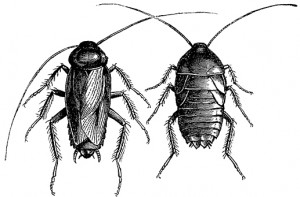The Oriental cockroach (Blatta Orientalis) has committed public health violations resulting from septic contamination of structures and food.
Aliases: “Asiatic Cockroach,” “Shad Roach” and “Waterbug”
Female: 1 3/8″ long
Male: 1″ long
Description: Shiny brownish-black. Adult female has wing stubs and male has short wings. Rear corners of the abdomen resemble a scallop outline.
Life Cycle: Gradual (egg, nymph, adult), averaging 16 eggs per ootheca with an incubation of 60 days (development may take more than 600 days). The capsule is typically cemented within a dark cavity (non-parental care).
Habitat: Structural basements, cellars, crawlspaces, ground floor cryptic areas, cinder block hollows, under radiators and floor coverings, and tree hollows.
Food: Sewage, organic waste, human-pet foods, and garbage. Starches are preferred.
Range: Temperate regions.
Significance: The second-most influential and pestiferous species behind the German cockroach (Blattella germanica), Oriental cockroaches live long and are fertile. Each female typically produces eight or more oothecae in its lifetime. Dense infestations produce a musty odor. Haphazardly feeding on feces and food, the cockroaches contaminate by regurgitation and excretion. They are capable mechanical vectors of pathogens, resulting in food poisoning. The cockroaches also produce allergens that play a role in poor indoor air quality and inhabitants’ related respiratory issues.
Dr. Mitchell, D.O., Ph.D., M.P.H., B.C.E., a board-certified physician and entomologist, is principal technical specialist for PestWest Environmental, as well as PMP’s Technical Editor. He can be reached at docmitchell@northcoastmedia.net or 515-333-8923.

Leave A Comment